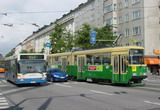Helsinki
Go to English main page
Helsinki area public transport history
Commuter trains connect suburbs and neighbour cities to Helsinki. They have own rails for the nearest distances from Helsinki, where the service frequency is high. Four track line is built to Hiekkaharju to the north from Helsinki and to Leppävaara to the west.
The railway line from Huopalahti station to north up to Vantaankoski is a two track commuter train only line. The original plan for this line was a part of the metro system, and the design of the stations is very much like on ground metro stations in Helsinki. The line was built together with the new suburbs and there was not time to wait for the metro development. The line opened as Martinlaakso line in 1972, 10 years before the metro opening.
When four track section to Leppävaara was under construction, pure feeder bus service was planned for trains too. For public resistance part of the straight bus services has remained. Anyhow commuter trains serve much as a base for feeder buses and park and ride. Trains are the fastest way to the city centre of Helsinki and require no parkig site.
Railways local traffic was developed to a S-Bahn-like style, and one commuter train line was built during 1970's to new suburb Martinlaakso. But the road traffic started to dominate Helsinki area transport. Metro line replaced the buses on the motorway beside. The bus lines were cut to end to metro stations, and the connecting feeder service system had born. This extended the travelling times. During the operating of the metro the share of public transport has decreased from 70 % to the recent 40 %.
Railways started to operate in Finland in 1862 from Helsinki to Hämeenlinna, 100 km's north from Helsinki. Public transport in the city of Helsinki started in 1888 with horse drawn carriages. First horse tram rails were laid in 1981 and electric power was taken into service in 1900.
Motor bus services started to grow in 1920's to the directions were rails were not built. For the first there was plenty of independent companies, but during the World War II Helsinki city bought the united transport company that was then organized to City Transport Authority.
Tramways expanded to the 1950's. New rolling stock was purchased for suburban services. Helsinki population expanded and suburbs were built outside the old city center. The public transport was planned to take care with high speed tram lines using multiple unit tram trains.
But then the automotive industry learned to make cars cheaper and cheaper, and the labor parties proposed in Helsinki City Council, that public transport must be put under ground to free the streets for private cars.
Closure of tramways in plan
During the 1960's plans were made to replace plenty of old buildings in the city center with motorways. Tramways were planned to close and public transport would be taken care with an underground system. This plan in knows as ”Smith–Polvinen traffic plan” according engineering agencies Wilbur Smith in USA and Pentti Polvinen in Finland as makers of the plan.
The motorway building was luckily cancelled, but in 1969 Helsinki signed an order to be a pilot customer for Valmet rail industry as new age metro train production. In Valmet the managers thought that the demand for heavy metro trains would explore in the world at the time the high cost of metro building led into cancellation of metro plans in many cities.
The key features of Valmet metro trains was welded aluminum body and 3-phase brushless drive motors with semiconductor control. These really were revolutionary technologies, but unfortunately applied to wrong kind of rolling stock. And what was also sad was, that these revolutionary trains were the largest in the world being wider than wide Finnish railway loading gauge, 3200 millimeters. This making the track geometry much similar to railway lines and difficult to implement into a city structure.
Soon after the metro decision the initial closure of the tramway system was cancelled and new articulated trams was ordered. The new plan was to close the system in 2000 and the ordered trams would be the last ones in Helsinki.
Political metro war
Trams finally to suburbs
New low floor trams were delivered to Helsinki from 1999. Some minor extensions of tram lines has been built for few new areas, but the Helsinki authorities consider trams as slow street tram system not capable for suburban service.
At the moment (2006) Helsinki has 555,000 inhabitants and population density is 3020 pers./sqkm. Helsinki city urban area has 1.2 million inhabitants with population density of 405 pers./sqkm. Urban area includes plenty of forest, so the population density at the built areas varies from 1000 to 1700 pers./sqkm.
The 120 units tram fleet carries daily 193,000 passengers. 108 metro coaches carry 182,000 and 167 commuter trains 88,000 passengers. So the trams are the most important public rail transport system even though the network covers only the city centre area of Helsinki.
Top of the page.
This page created at 9.10.2007 / AA | latest update 9.10.2007 / AA

